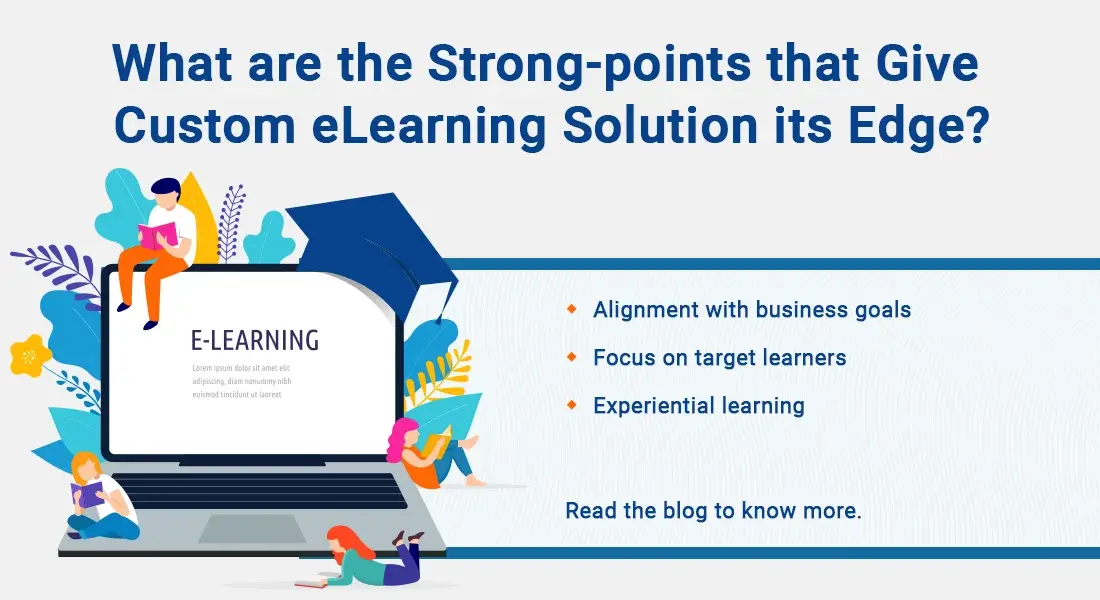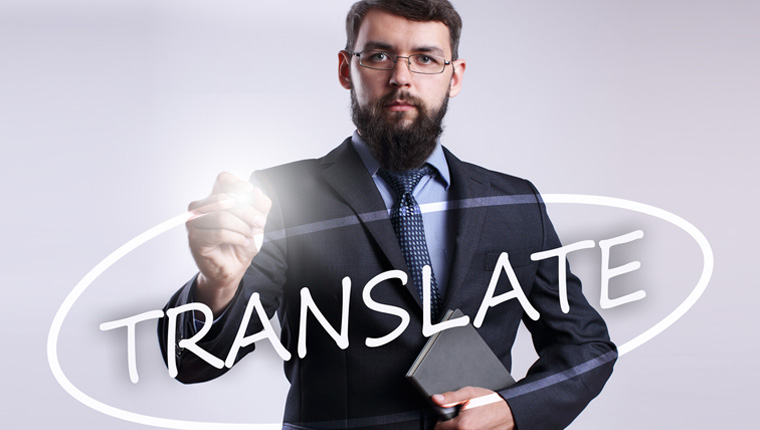4 Amazing Ideas to Make your Custom eLearning Solutions Stick

“We need to bring learning to people instead of people to learning.”
– Elliot Masie
As L&D professionals, we sure are living in an interesting time right now. Gone are the days when elaborate plotting was needed to convince, cajole, or coerce stakeholders about online training. Now, most stakeholders are eagerly waiting to jump on the online training bandwagon. But while this is much appreciated, there’s another knot we have to untangle before long. Off-the-shelf or custom eLearning solutions?
Learning, according to any pedagogue, can be very effective when it is customized to the learner’s needs. If the learner is a factory worker or a corporate employee, then the factory or the office becomes his learning workspace. A bit of structure and purpose can be woven into this informal learning pattern through formal learning initiatives. Ideally, such learning programs should be integrated into his daily work hours and should match the organization’s work processes. Custom eLearning solutions are a good fit for this requirement.
→ Download eBook: Corporate L&D Trends 2025 – Get the View from the Trenches
Table of Content
- What Is Custom eLearning?
- Why Custom eLearning Should be a Preferred Choice for Corporate Training?
- What Are the Benefits of Custom eLearning?
- What are the Must-have Characteristics of Custom eLearning Solutions?
- How to Make Your Custom eLearning Solutions Stick?
What Is Custom eLearning?
Custom eLearning refers to creating online training programs specifically designed to address the unique needs, goals, and preferences of an organization and its employees. Unlike generic, off-the-shelf eLearning solutions aimed at a wide audience, custom eLearning is tailored to the specific challenges, objectives, and learning styles of the organization’s staff. It also reflects the company’s culture and branding.
The custom eLearning development process requires close collaboration between instructional designers, subject matter experts (SMEs), and organizational stakeholders. This teamwork ensures that the training content is both accurate and relevant while aligning with the company’s values, policies, and business objectives.
Custom eLearning can be used to cover a wide range of topics in corporate training. These include:
- Onboarding training
- Product training
- Technical training
- Sales enablement
- Compliance training
- Leadership training
- Sustainability training
In summary, custom eLearning delivers a personalized learning experience tailored to the organization and its workforce. By addressing specific learner needs and organizational goals, custom eLearning is better positioned to achieve desired outcomes and generate higher returns on investment (ROI) than standard off-the-shelf eLearning options.
Why Custom eLearning Should be a Preferred Choice for Corporate Training?
Custom eLearning provides an alternative to cumbersome and expensive classroom training programs. With the help of custom eLearning solutions, knowledge transfer is expected to take place in a cost-effective manner with manageable durations of training. It is to be a learning resource that learners can access anytime and anywhere through the Internet. However, if you are not careful, eLearning could lead you to make costly mistakes. Many of the eLearning solutions failed to perform due to mistakes by developers, who do not foolproof themselves against bottlenecks or problems.
What Are the Benefits of Custom eLearning?
Just as a blacksmith forges a unique sword to suit a knight's hand, custom eLearning is the secret weapon of modern businesses to sharpen their employees' skills and knowledge. Custom eLearning assets ensure a perfect fit and style that suits the needs of the learners and help organizations achieve their training goals efficiently and effectively. Based on this practice, custom eLearning assets offer multiple benefits.
Let’s have a look!
What are the Must-have Characteristics of Custom eLearning Solutions?
5 Reasons Why Custom eLearning Solutions are Better than Off-the-shelf Courses
- Aligned to Business Goals
- Customized to Learners’ Needs and Requirements
- Focus on Experiential Learning
- Targeted Assessments to Measure Learners’ Ability to Perform
- Support Organizational Branding
1. Aligned to Business Goals
All too often we forget that custom eLearning for organizational training is not the same as eLearning for school students. Training in corporate organizations is not just aimed at improving knowledge. It is much more utilitarian than that. Corporate training always has an end goal, to improve learners’ performance and productivity and in turn, help the organization achieve its goal. So, it can’t be stressed enough how important it is to align all aspects of an eLearning course, be it content, instructional design, or duration, to the business goals.
This surely can’t be achieved with off-the-shelf courses where the information is more or less generic. But with custom eLearning, you get an opportunity to create a training solution that is aligned to your organization’s unique business goals. And the thing that keeps every aspect of an eLearning solution aligned with the ultimate business goals is the performance-based learning objectives.
Learning objectives convey what specific tasks/skills the learner will be able to do by end of that course, thereby setting the framework around which the entire custom eLearning solution can be created to bring coherence and specificity to the training. Without specific learning objectives aligned to business goals, a custom eLearning solution is no better than any random off-the-shelf course.
2. Customized for Target Learners’ Needs and Requirements
In the whirlwind of designing and developing eLearning solutions (which certainly is an extensive process), it is easy to forget that the most important stakeholders are the learners and the goal is effective knowledge transfer. And the only way any training solution can achieve that impact is if learners get the exact information that will help them do their job tasks and also keep them engaged during the training. So, as the name suggests, custom eLearning solutions should be customized for your organization’s learners and their needs and requirements.
How can you do that? It’s quite simple.
- Only you have the information on the kind of talent your organization attracts and recruits. Only you know how these employees can become a part of your organization’s culture. So use that information to develop a custom eLearning solution that can help them fit-in better.
- When you don’t know where to start, a Training Need Analysis always works. Scratch that, a TNA always works, and is necessary to understand the needs and requirements for any training. You can use that information to create training solutions custom-made for your learners.
- A direct survey-feedback process involving employees can help get direct insights into the problems employees face in their day-to-day job roles and what kind of training can help solve them.
- Always consider your learners’ demographics. A multigenerational workforce training has a better success rate if your custom eLearning solution includes multi-modal or blended learning approaches. A predominantly millennial or Gen Z workforce will want a flexible and edutaining eLearning solution. A global, linguistically and culturally diverse learner demographic will need eLearning translation to become a success.
3. Focused on Experiential Learning
One of the major complaints that stakeholders have had about eLearning over the years is that it distances learners from real life. And it is understandable how it can seem that way. In classroom training or on-the-job training, learners could get a glimpse of the reality of their work environment and even hands-on experience in some cases. With eLearning, the learning experience is individual and limited to virtual interaction with a screen. And off-the-shelf courses often make this problem worse with their generic information and examples.
But does that mean there can be no experiential learning with online training? Of course not! In fact, with custom eLearning, the problem can be solved at multiple levels.
- With a custom eLearning solution, you can use scenarios and case-studies from your own organizational experience to help learners get a more concrete idea of the kind of problems they might face and possible solutions to resolve them.
- You can use branching scenarios, simulations, AR/VR within eLearning courses to give learners a more hands-on experiential learning in a safe environment. This can be done even for training areas where hands-on training is expensive or risky, for example fire safety training.
4. Targeted Assessments to Measure Learners’ Ability to Perform
When we talk about custom eLearning solutions, it’s not just the training content but the assessments also that have to be aligned to organizational goals. eLearning assessments have always been about testing learners’ knowledge, but it should go beyond that. With corporate eLearning courses, the goal of assessments shouldn’t just be about testing learners’ ability to recall information but focus on its application in their job tasks.
And custom eLearning solutions give you the perfect opportunity to break the monotony of fill-the-blanks and match-the columns and replace them with assessments that test your learners’ ability to perform.
Design better eLearning assessments with these 4 key tips to engage learners and measure their progress effectively!
5. Organizational Branding
Corporate training has evolved a lot over the years and today it presents a unique opportunity for you not just to promote a learning culture but to also reflect your organization’s values that your employees need to understand and embody. And since no two organizations are alike, nor are their values, goals, achievements, and challenges (even your closest competitors are ever so slightly different than you), with a custom eLearning solution you can truly be able to promote your organization’s brand.

Corporate L&D Trends 2025
Get the View from the Trenches
- Win with AI
- Design for the agile workforce
- Unlock scale, volume, quality
- Make an impact
- Much more
How to Make Your Custom eLearning Solutions Stick?
Following are some guidelines that every eLearning developer should follow for the successful implementation of eLearning programs.
1. Create a Watertight eLearning Solution
You need to have a clear framework regarding the eLearning program – What is the program going to achieve? Who are the beneficiaries of the program? How will the program change their performance? The benefits to the individual and the organization as a result of the program. By creating a well-designed, watertight custom eLearning solution, you ensure that all participants can upgrade their knowledge and skills at their convenience. They have control over investing time for learning, whenever they need it and in the format that suits their needs and learning styles.
2. Choose the Right eLearning Authoring Tools
The choice of the rapid eLearning authoring tool depends on your requirements and the interactivities that you wish to have in your course. Built-in interactivity, whether explicit or implicit enables learners to engage with the material rather than merely listen or view it. By choosing the right rapid eLearning authoring tool, you can cater to users with varying learning preferences. Only then does the learning experience become total and complete. Check out this presentation that provides details about popular authoring tools and gives tips on choosing the right authoring tool for your eLearning program.
3. Choose eLearning Vendors who Understand your Custom Needs
When going for eLearning outsourcing, you should choose eLearning vendors who recognize your needs and problems and offer custom-designed solutions. Chosen vendors should have adequate experience, expertise, and a good track record in instructional design, content, and technology. They should demonstrate knowledge and experience in using the relevant rapid eLearning authoring tools that you wish to use for your courses. Assess their project management capabilities, their processes, and quality mechanisms in place to ensure that you get a product that meets your stringent standards. Evaluate the team that is likely to work on your project and ensure that there is a single point of contact from the vendors’ side, who will address all your concerns and keep you updated on the progress of the project.
Watch this video for insights on how to choose the right eLearning vendor.
4. Market your Initiative Internally so that your Users Understand its Value
No eLearning initiative will be a success if you do not devote adequate time and resources to educate your target users about it. They need to know why they should take time off to take a course. They need to be explained how this investment will help them further their career goals or aid in their performance improvement. Merely uploading courses onto a portal and sending an isolated email will not solicit participants. There needs to be a proactive promotional program to popularize eLearning initiatives in the organization, as per the delivery timelines.
Wrapping Up!
I hope this blog on the key strengths of custom eLearning solutions has provided valuable insights and given you some food for thought. When it comes to achieving your organization's long-term learning and development (L&D) goals, custom eLearning solutions offer unmatched benefits. Unlike off-the-shelf courses, custom solutions are specifically designed to address your unique business objectives, learner needs, and organizational challenges. They provide greater flexibility, scalability, and relevance, ensuring an engaging and impactful learning experience.
Investing in a tailored eLearning approach not only enhances the learning outcomes for your team but also delivers a significant return on investment over time. With the ability to adapt to evolving needs and integrate seamlessly with your existing systems, custom eLearning solutions empower organizations to foster a culture of continuous growth and innovation.
Say goodbye to generic corporate training and empower your team to thrive!
As we approach 2025, staying ahead of the latest workplace learning trends is more important than ever. Download our eBook, "Corporate L&D Trends 2025," and explore how personalization, cutting-edge technologies, and innovative strategies are revolutionizing employee training and development.







![10 Must-Know Tips for Rapid eLearning Course Rollout [Infographic]](https://blog.commlabindia.com/hubfs/blogs/tips-rapid-elearning-course-rollout-infographic.jpg)

